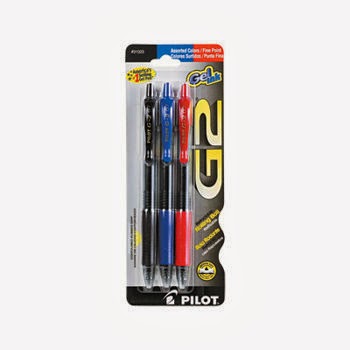Revising the Novel: Logistics on Paper
I wrote most of the first draft by hand, sometimes using shorthand or abbreviations (N for Nathan, b/c for because, etc.). I wrote on blank, white pieces of paper that were in my “seconds” pile next to the printer–pages I had printed for something or other at one point in time, but no longer needed. Keeping this early drafting process as informal and “un-precious” as possible helped me take my own expectations down a notch. After all, I was just scribbling on the back of recycled paper, wasn’t I? Just leaning into the couch still wearing my pajamas, scribbling away on a clipboard, seeing what would happen. No pressure.
 |
| Technically, the Pilot G2 Retractable Gell Rollerball |
I did, however, number my pages and occasionally re-read them, making scribbles and small line-level edits as I went along, then picking up where I’d left off the day before. This was a sort of warm up for me, and over time I added a few complementary sheets of paper to help organize my thoughts–I listed character names and ranks, places, significant dates or events that had happened in the novel so far, and even a few stick figure sketches of physical arrangements for more technical scenes. I had to store the information some place, but wasn’t yet ready to leap onto the computer.
Oh, and I did it all with my blue, black, or red Pilot G2 Rollers, of course. They write like a Uniball (my former favorite) but don’t explode on airplanes (boo Uniball) and they don’t have caps you can lose. Also, they come with handy refills, which I feel quite righteous using. Just don’t get the “fine point” version because they lose that Uniball-floaty-feel and start to take on the “over-sharpened pencil” feel.
I wasn’t a complete Luddite during all of this, however. After a few days of successful sessions drafting by hand, I found it very helpful to go back to my shorthand writings (which now had added, small changes etched over the top of them), and type what I had drafted into the computer. Inevitably, more small changes were made during this process and in that way, the “real first draft,” I believe, is damn near impossible to ever pinpoint. Sentences begin before we even put them on the page, and the very act of writing or typing them changes how they come out from thought to breath to ink. Add in the re-reading and tinkering, then the leap from paper to computer, and somewhere in the middle there’s this abstract concept of a “First Draft.”
I continued this process until I wrote my way–still by hand–to the every end of the novel in its first run-through. As I was coiling back and typing the scenes from the days or week prior, I used Microsoft Word. I considered Scrivener but decided, ultimately, that it would distract me more than help me. I didn’t want to lose my forward momentum by having to learn a new software program. Knowing what I know now, however, I might have taken the time to look into Scrivener more carefully. Writers I know and love, such as Shannon Huffman Polson and Molly Gloss, use this program and swear by it. Certainly now, many drafts later as I’m working scene-by-scene, I realize it might have been helpful.
That’s how it worked on paper. next up I’ll discuss how revision works for me on the screen!

